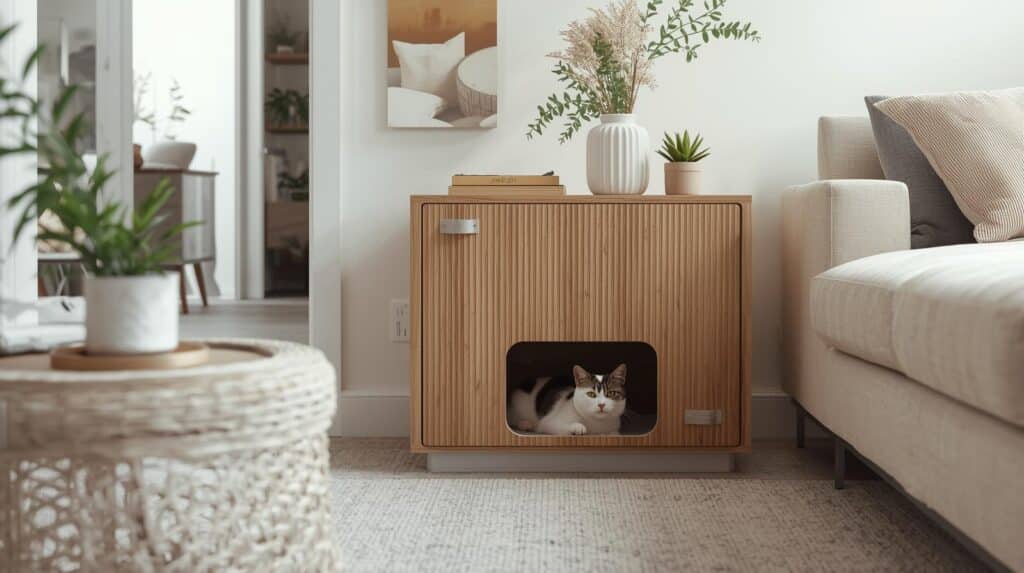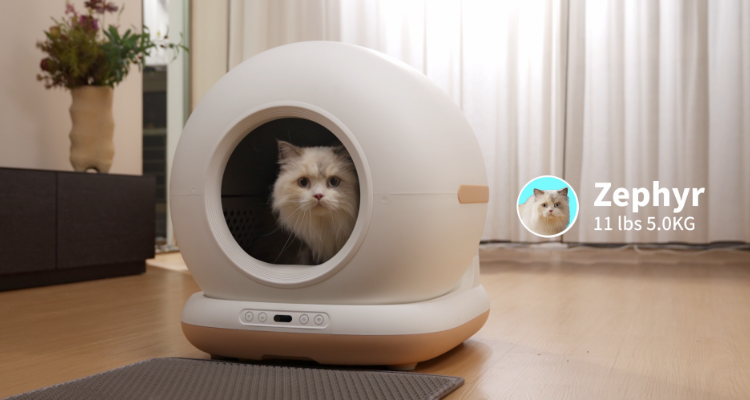How to Set Up a Clean, Odor-Free Litter Area at Home (Expert Guide, 2025)
Date: 2025-11-20 Categories: Reviews Hits: 281
How to Set Up a Clean, Odor-Free Litter Area at Home (Vet-Approved Expert Guide)

A well-organized, odor-free litter area with proper ventilation and cat-friendly design to keep your home fresh.
1. Why Odor Matters for Cats & Homes
Odors from a cat litter box are not just an annoyance — they can indicate poor hygiene, ventilation issues, or even medical problems in your cat. According to the ASPCA, litter box avoidance often originates from management issues, such as not cleaning the box often enough or using a box that is too small. (ASPCA)
Moreover, lingering ammonia from cat urine can irritate both human and pet respiratory systems. Reducing odor isn’t just about masking—it’s about preventing buildup with proper litter box maintenance.

A clean litter box encourages regular use and reduces odor buildup, preventing litter box aversion.
2. Choosing the Best Litter Box Location
Ventilation is critical. Place the litter box in a well-ventilated area to allow airflow to disperse odors rather than trap them. Experts stress that poorly ventilated closets or tight spaces exacerbate smells. (The Hervey Foundation for Cats)
Accessibility for your cat. The box should be easy to reach at all times, especially for older, young, or mobility-impaired cats. According to Ontario SPCA guidance, litter boxes should be placed in quiet, easily accessible spots, away from loud appliances or high-traffic areas. (Ontario SPCA and Humane Society)
Separate from food/water. Cats tend to avoid eliminating near where they eat or drink. To reduce stress and improve hygiene, locate litter boxes away from feeding stations. (Ontario SPCA and Humane Society)
Adequate number and distribution. The Ontario SPCA recommends having one litter box per cat, plus one extra. For multi-level homes, distribute boxes on each floor to reduce territorial or access issues. (Ontario SPCA and Humane Society)
3. Selecting the Ideal Litter Box (Size & Type)
Open vs. covered: While covered boxes can help contain smell, they may trap ammonia inside and discourage use. Many cats actually prefer open boxes due to better ventilation and multiple escape routes. (Ontario SPCA and Humane Society)
Size matters: A box that’s too small can prevent proper digging and burying, while too-deep litter may deter use. ASPCA recommends boxes large enough for your cat to turn around comfortably, with roughly 1–2 inches of litter depth in many cases. (ASPCA)
Box material: Choose a plastic box with smooth surfaces to make cleaning easier. And avoid strongly scented liners — some cats find them off-putting, and they may trap odor. (Ontario SPCA and Humane Society)
Multiple boxes for multiple cats: As noted, use the “one plus one” rule — provides options, reduces crowding, and helps minimize odor concentration. (Ontario SPCA and Humane Society)

Open litter boxes (left) offer better ventilation, while covered boxes (right) provide privacy — choose based on your cat’s habits.
4. Best Cat Litter for Odor Control
Litter choice plays a major role in odor control. Here’s what to look for in the best cat litter for odor:
Clumping, unscented litter: Many cats prefer clumping, fine-grained, unscented options, which help isolate urine and allow for easy scooping. (ASPCA)
Absorbent materials: Silica crystal litters and plant-based litters (like tofu or wood) are highly absorbent and can trap moisture quickly, which helps curb ammonia smell. Natural Paw highlights how fast-clumping, low-dust tofu litter reduces odor without masking it. (Natural Paw)
Avoid excessive scent: Strongly fragranced litters or deodorizers may actually discourage your cat from using the box. The Ontario SPCA warns that artificial scents can trigger aversion. (Ontario SPCA and Humane Society)
Litter depth: Too much litter can hinder clumping. Some experts suggest lower depths (1–2 inches) for clumping litters, depending on your cat’s preferences. (ASPCA)
5. Effective Litter Box Cleaning Routine
A consistent litter box cleaning routine is the backbone of odor control.
Daily scooping: Scoop solid waste and clumps at least once daily — or even twice a day in multi-cat households. This is one of the most effective ways to reduce odor buildup. (Ontario SPCA and Humane Society)
Weekly maintenance: Empty some or all of the litter (depending on your litter type), then wash the box with unscented mild soap and hot water. Avoid harsh chemicals, as residue or strong smells may discourage your cat. (Ontario SPCA and Humane Society)
Monthly deep clean: Perform a full litter replacement regularly. During this, scrub the box thoroughly, rinse well, dry fully (sun-drying helps), and optionally sprinkle a thin layer of baking soda at the bottom before refilling — this helps neutralize ammonia. (Ontario SPCA and Humane Society)
Accident cleaning: Use an enzymatic cleaner to tackle urine or fecal accidents. Because bacteria produce ammonia over time, enzymatic cleaners break down odor-causing compounds rather than just masking them. (homewardpet.org)

Essential cleaning tools for a odor-free litter box: unscented soap, enzymatic cleaner, scoop, and baking soda.
6. Vet-Approved Odor-Control Tools & Accessories
Beyond routine cleaning, adding the right tools can dramatically improve the litter area environment. Here are the top litter box odor solutions:
Baking soda: A thin sprinkling of baking soda at the bottom of the box helps absorb odor. Many reputable sources (like Ontario SPCA) endorse this as a safe, effective deodorizing method. (Ontario SPCA and Humane Society)
Charcoal or odor-absorbing mats: These mats, placed under or around the litter box, help trap litter and absorb smell. The Hervey Foundation highlights activated carbon or rubber mats as durable, odor-fighting accessories. (The Hervey Foundation for Cats)
Air purifiers: A HEPA air purifier with a carbon filter can help remove airborne particles and gaseous odors like ammonia. This is recommended by experts as a non-chemical, continuous odor-control solution. (alen.com)
Smart deodorizers / ionizers: These devices neutralize odor molecules continuously, rather than masking them with scent. Combining one with proper cleaning significantly reduces lingering litter smells.
7. Health Signals: When Odor Indicates a Problem
Persistent odor may not always be management-related; sometimes it signals a health issue.
The ASPCA emphasizes that litter avoidance could be rooted in medical problems, such as urinary tract infections (UTIs), interstitial cystitis, or kidney issues. (ASPCA)
If you’ve ruled out cleaning and location issues, and odor remains strong, it’s wise to schedule a vet visit to check for underlying conditions.
Also, if your cat shows signs of litter aversion (e.g., avoiding the box after using a strong scented cleaner), retraining may be needed. The Ontario SPCA suggests gradually switching to unscented litter, reducing litter depth, or even replacing the box. (Ontario SPCA and Humane Society)
8. Odor-Free Litter Area Maintenance Checklist
Here is a quick reference checklist to keep your litter area odor-free:
| Task | Frequency | Key Notes |
|---|---|---|
| Scoop waste | Daily (1–2×) | Remove clumps immediately to reduce ammonia buildup. (Ontario SPCA and Humane Society) |
| Empty & wash box | Weekly | Use mild soap, avoid strong scents. (Ontario SPCA and Humane Society) |
| Deep clean + litter replacement | Monthly (or as needed) | Dry box completely; add baking soda layer for extra odor control. |
| Monitor box health | Ongoing | Watch for lingering smell — could indicate illness. (ASPCA) |
| Use odor-absorbing tools | Continuous | Baking soda, charcoal mats, HEPA air purifiers, smart deodorizers. (The Hervey Foundation for Cats) |
9. Final Thoughts
Creating and maintaining a clean, odor-free litter area is about more than just masking smells — it’s about smart design, consistent maintenance, and using the right tools. By choosing the proper box, litter, and location, establishing a regular cleaning rhythm, and enhancing your setup with odor-absorbing accessories, you can significantly reduce litter-related odors.
Plus, staying alert for signs of persistent smell can help you catch potential health issues early. When you follow these expert-backed steps, you’re not just keeping your home fresh — you’re supporting your cat’s well-being and comfort.
FAQ: Clean & Odor-Free Litter Area at Home
Urine has soaked into scratched plastic
Inadequate ventilation around the box
Low-quality or heavily scented litter
Underlying medical issues such as UTIs
Good ventilation
Easy access
Low noise
Distance from food and water
Clumping unscented litter (ASPCA recommended)
Silica crystal litter
Tofu or plant-based litter (high absorption, low odor)
Weekly for non-clumping litter
Every 2–4 weeks for clumping litter
Strong ammonia smell that persists even after cleaning
Blood in urine
Frequent trips to the litter box
Urinating outside the box
Sources & References
1. ASPCA: Litter Box Problems
2. The Hervey Foundation for Cats: Litter Box Guide
3. Ontario SPCA and Humane Society: Sifting Through Litter Box Options
4. Ontario SPCA and Humane Society: Litter Box Best Practices
5. Natural Paw: Say Goodbye to Litter Box Odor
6. Ontario SPCA and Humane Society: Solving Litter Box Dilemmas
7. Ontario SPCA and Humane Society: Five Tips to Combat Smelly Kitty Litter
8. homewardpet.org: Cat Litter Box Care
9. alen.com: How to Get Rid of Cat Litter Smell
